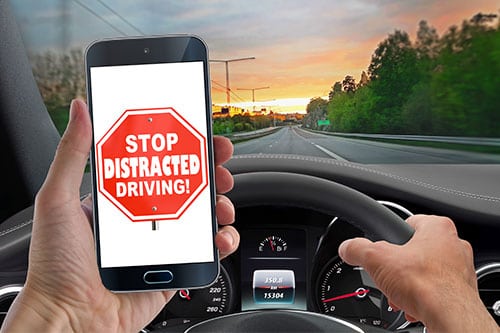Some traffic accidents are probably unavoidable, the result of bad weather, a mechanical failure, or poor road conditions. But the vast majority of mishaps on the road are preventable. Numerous studies of crash causation, conducted in the United States and elsewhere, have concluded that human error accounts for more than ninety percent of all crashes. Some of the most obvious forms of error include excessive speed and driving while intoxicated.
Add to that list of risky behavior a bad habit that’s more dangerous than most people realize: Driving While Distracted. According to data compiled by the National Highway Traffic Safety Administration, distracted driving was involved in nearly one out of ten of all fatal traffic accidents in the U.S. in 2016. Of the 37,461 people killed on the roads that year, 3,450 lost their lives in what the NHTSA describes as “distraction-affected crashes.”
Definition and Types of Distracted Driving
Since the advent of the smart phone, considerable media attention has focused on drivers who are texting, or otherwise using cell phones, as the parties responsible for many crashes. But while phones are certainly one culprit, they’re not the only cause. In fact, cell phones were identified as a factor in only 14% of the distraction-affected crashes.
The NHTSA defines distracted driving as “a specific type of inattention that occurs when drivers divert their attention from the driving task to focus on some other activity instead.”
A few types of distracted driving include:
- Being engrossed in a conversation (or argument) with a passenger
- Fiddling with climate controls or an audio system, studying navigational devices
- Being distracted by the demands of eating or smoking while driving
- Anything else that takes your eyes off the road for more than a moment
The diversion doesn’t have to take up much time to be deadly; in five seconds, a car proceeding at 70 miles per hour can cover more than 600 feet, the length of an average city block.
There are problems in comparing data over time, as different agencies that collect data only began to coordinate how they define and code different types of distraction fairly recently. Despite efforts to curb behavior such as texting through legislation (more on that below), the percentage of fatalities related to distracted driving has remained fairly constant over the past five years. That may be due to the increasing number of distractions available as more cars hit the market equipped with navigation devices, wifi, satellite radio, entertainment systems, and other diversions.
ARE SOME DRIVERS MORE LIKELY TO BE DISTRACTED THAN OTHERS?
Age does appear to be a factor in distracted driving. The data on distraction-affected fatal crashes indicates a disproportionate number of the distracted are drivers under the age of 30. In particular, the 15- to 19-year-old age group “has the largest proportion of drivers within each respective age group who were distracted.”
Unfortunately, the numbers don’t improve significantly with drivers in their twenties, especially in cases where cell phones were involved. Statistically, drivers under the age of 30 were involved in less than a third of all fatal crashes in 2016, but that same age group comprises approximately half of the distracted drivers who were using cell phones in fatal crashes.
WHAT CAN BE DONE TO AVOID DISTRACTED DRIVING?
Over the past several years most states have enacted legislation to combat distracted driving, typically by putting restrictions on motorists’ cell phone use. Sixteen states, as well as the District of Columbia, Puerto Rico, Guam, and the U.S. Virgin Islands, prohibit drivers from using hand-held cell phones while driving. Although some studies suggest that Bluetooth use can be just as distracting as a hand-held phone, no states prohibit all cell phone use while driving. Some restrict novice or teen drivers or school bus drivers from using them, though.
For texting, the restrictions are more consistent. Forty-seven states ban text messaging while driving. The holdouts are Arizona and Montana, while Missouri won’t let drivers 21 or younger text. A state-by-state list of laws concerning cell phones and driving has been compiled by the National Conference of State Legislatures.
So far the legislation hasn’t made much of a dent in the fatality rate — but, as noted above, cell phones are only part of the problem. There are a number of steps drivers can take to make their own experience on the road safer and less prone to distractions. Here are a few:
- Take a few moments in your driveway or parking space to prepare for your trip before you pull into traffic. Adjust mirrors, seats, climate settings, GPS, and radio, and buckle up, so you can focus on driving once you’re underway.
- Makeup, neckties, and other grooming should be done before you even get in the car. Seriously.
- Make sure everything is in its proper place, including pets, small children, or loose objects that otherwise may divert your attention from the road.
- Avoid turning your car into a rolling cafeteria. Avoid messy takeout orders and huge drinks. If you must snack, snack neatly.
- Turn off your cell phone. If a call is too important to miss, it’s best to pull over so you can give it your undivided attention.
- If something else intrudes in the course of your journey that requires action on your part, pull over to deal with it.
- If you see another vehicle moving erratically or exhibiting other signs of a distracted driver, make an immediate report to authorities. But pull over to do it. In such cases, seeking guidance from experienced motor accident lawyers can help protect your rights and pursue appropriate legal action.
THE CAR ACCIDENT LAWYERS AT FDAZAR
If you or a loved one is involved in a car accident, contact the offices of Franklin D. Azar & Associates. For the past thirty years, the car accident lawyers at FDAzar have successfully represented thousands of injured clients, fighting to get them the compensation they deserve. Our website features a wealth of helpful information about what to do immediately after an accident, the options you have if your insurance company delays or denies your claim, and how to protect yourself in the event that the other driver has no insurance, as well as safety tips.
Call us for a free consultation or contact us here.
Free case evaluation. Contact us now!



